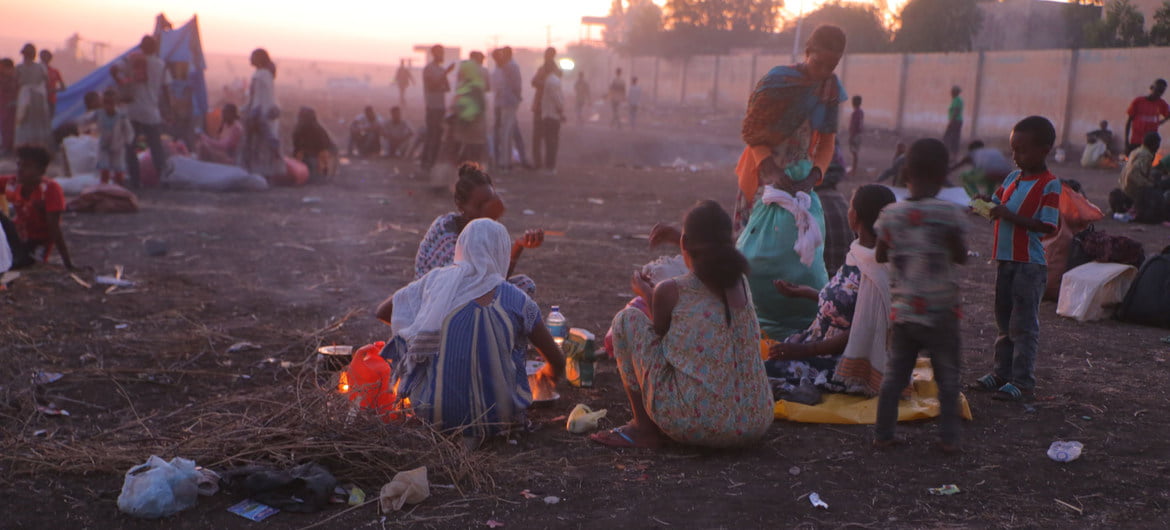By Refugees International Senior Fellow Dr. Sarah Miller,
Being in Ethiopia’s northern Tigray region right now is difficult for anyone. Famine, conflict, and sexual violence are prevalent, and communications and humanitarian aid are largely cut off. But the situation is particularly difficult for Eritrean refugees in Tigray, who seem to be taking fire from all sides.
Eritrean refugees in Tigray have been kidnapped, attacked, killed, raped, harassed, and threatened by nearly everyone party to the conflict: Eritrean troops, Ethiopian forces, Amharan militia, Tigrayan forces, and other groups. Many are now trapped in camps where they remain under threat, and aid groups are not able to reach them. UNHCR reports that healthcare is unavailable, and clean drinking water is running out. Last month Mohamed Abdelsalam Babiker, the Special Rapporteur for Human Rights in Eritrea, called for increased protection for Eritrean refugees in Tigray, as well as in other parts of Ethiopia. Some 80,000 of them are now at risk.
Urgent action can help stave off the worst of the crisis. It is not too late. But time is running out.
Earlier this year, Eritrean troops razed the Hitsats and Shimelba refugee camps in Tigray, Ethiopia to the ground, leaving only “smoldering ruins” and “collapsed roofs.” In a short period of time, some 20,000 refugees from those camps were missing.
Some managed to flee on foot, eating leaves as they sought safety, while others were abducted back to Eritrea. Still others were raped or killed. The lucky ones turned up in Tigray’s southern refugee camps, or in other parts of Ethiopia, including Addis Ababa. Smaller numbers fled to Sudan’s newly erected refugee camps, where the rainy season is now underway, and assistance is limited.
However, with a shift on the battlefield in June, Eritrean refugees who found refuge in the southern camps are once again trapped and desperate, facing attacks, intimidation, and harassment. UNHCR reported that it was unable to reach the camp for weeks, and the last food distribution was carried out in the end of June. It only recently regained access on August 5. While it is working with Ethiopia’s Agency for Refugees and Returnee Affairs (ARRA) to construct a new camp elsewhere in Ethiopia, there are no guarantees for the safety of these Eritrean refugees. And an increasing ethnically charged tone to the conflict could mean more attacks on refugees.
Nearly all civilians in Tigray are suffering, and desperately need humanitarian assistance and access to their basic rights. Some 1.7 million have been internally displaced, and another 63,000 have fled to Sudan. Humanitarian access is still minimal, despite some 90 percent of people needing food aid and skyrocketing child malnutrition rates. Famine conditions have set in, leaving a staggering number of people—most of them children—at risk of starving to death. Conditions are being compared to the infamous 1984-5 famine, which took the lives of more than 1 million people and projected images of emaciated children around the world. Today, starvation is in fact being used as a weapon of war.
Amongst the widespread suffering, refugees are especially vulnerable. They fled persecution at home, and are now in a host state that is unwilling and unable to protect them, despite its obligations under domestic and international law. On top of this, refugees are less likely to have access to networks and opportunities that could help them cope with the crisis and lessen the negative impacts.
Several steps should be taken to help vulnerable Eritreans in Tigray. First, the international community must continue to press for full humanitarian access to Tigray, including consistent, unfettered access and delivery of aid to refugee camps. Without this, the famine will worsen and hundreds of thousands of lives will be lost.
Second, the government of Ethiopia, with the help of the international community, should ensure that all refugees are able to leave Tigray immediately. UNHCR and ARRA should work together to help refugees find intermediate and long-term solutions to the threats they face in Tigray and their displacement more broadly. This could include relocating to other parts of Ethiopia, be it camps or self-settlement options. But camps should not be the only option, and refugees should have a say in the solution to their displacement.
Third, the United States and other states participating in formal third country resettlement with UNHCR should provide formal resettlement places for especially vulnerable Eritrean refugees inside Tigray. UNHCR, the State Department, and others should create fast-track processes to screen, process, and bring these refugees out of harm’s way.
Tigray is running out of time. All civilians in Tigray need immediate access to assistance, but Eritrean refugees have particular needs. With famine setting in and violence continuing, the international community must do more to look out for this vulnerable group.
